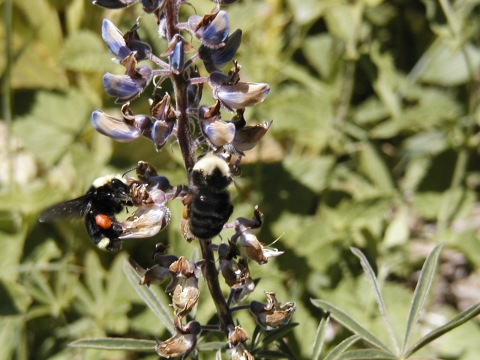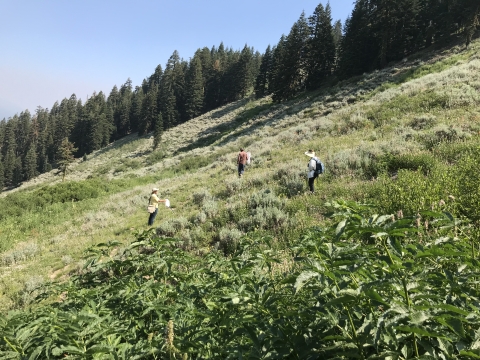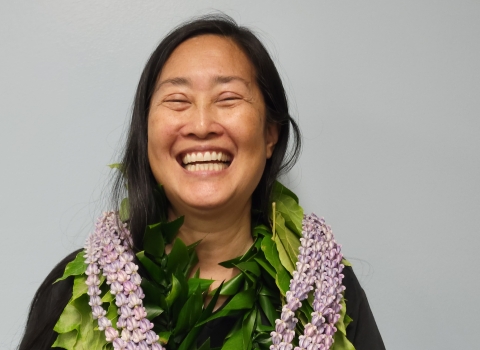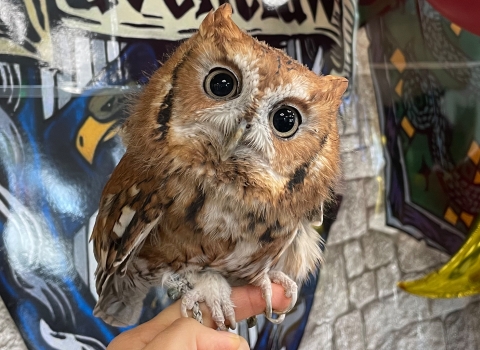While pollinators may be facing tough times around the globe, there is a new generation of scientists working to pave the way for the future of pollinator conservation.
The U.S. Fish and Wildlife Service (USFWS) and U.S. Geological Survey(USGS) teamed up this summer to mentor and support four Directorate Fellows (DFPs) on pollinator conservation projects across the Service’s Columbia-Pacific Northwest Region. From completing on-the-ground surveys, to doing cutting edge genetics work in the lab, to mapping pollinator habitat restoration efforts, Ahkil Kholwadwala, Erica Sarro, David Blake and Maddie Tango hit the pollinator conservation problem from all different angles.
The Directorate Fellow Program is a unique program within the USFWS that selects students in undergraduate and graduate programs to participate in an 11- week internship where they work full-time for the Service on a project. After completing their projects and their undergraduate or graduate degrees, they are eligible for direct hire status through the Department of the Interior. The program is a win-win for students and the Service – giving students the opportunity to experience working as a USFWS employee while in turn helping the Service complete important projects and recruit an outstanding new and diverse workforce.
Erica, David, and Ahkil’s DFP project’s this summer focused on bees– particularly locating rare species of bees like the western bumble bee and the recently listed as an endangered species, Franklin’s bumble bee.
“One of the best things we can do for these rare species of bees is find them. Once we find them, we can then focus on how best to conserve them,” said Jeff Everett from the Service’s Oregon Fish and Wildlife Office.
Jeff mentored David, Erica and Ahkil in partnership with staff from the Service’s Ecological Services Program Yreka Field Office in the California-Great Basin region as they conducted bee and flower surveys across Ashland, Oregon. No Franklin’s bumble bees were found during the surveys, but the team was thrilled when they found a western bumble bee queen – let alone the first bee of the season.
“Queens are not very abundant on the landscape, as compared to workers – so finding a queen of one of our rare and declining species is always exciting. Further, finding one of the new queens, who will mate, hibernate and establish a colony of her own next year, indicates that the colony she came from was successful enough to produce the next generation. This is exciting as it means that on some level, one of our target species had all of the resource needs (food, habitat, etc.) to complete a colony cycle, and that means good things overall,” Jeff said.
The survey data Erica, David and Ahkil collected provides valuable information on the status of current bee populations, locations and flower resource availability. It will be used in the future to improve Service habitat models, refine bumble bee survey methods and locations, and help inform high priority zones for pollinator conservation efforts. The data will also be shared with the Oregon Bee Atlas and the Pacific Northwest Bumble Bee Atlas projects.
But the effort to find these rare bees did not stop when DFP boots left the ground in Ashland. After six weeks in the field surveying for bees and collecting flowers, Ahkil continued the search for Franklin’s and westerns, but this time in a lab coat in Boise, Idaho. Funded by the Service’s Columbia-Pacific Northwest Region Science Applications Program and led by the region’s Ecological Services Program and USGS, Ahkil spent the second half of his DFP at USGS's Forest and Rangeland Ecosystem Science Center in Boise, Idaho exploring a potential new method for finding rare bees – eDNA. When animals come into contact with parts of their environment, like when bees pollinate flowers, they leave behind their DNA.
Ahkil worked with Dr. David Pilliod from USGS to study whether testing the flowers he collected from bee habitat in Ashland for eDNA could reveal what species of bees were recently active in that area. Results from the study are not yet ready, but all parties involved are excited about the work’s potential. If the study is successful in identifying rare bee species from the flower samples, it could mean scientists will be armed with a new tool to monitor for bees and potentially other pollinators in the future.
Although Ahkil finished his DFP before results of the study were ready, he is grateful for other takeaways from his DFP experience.
“This project helped me to refine what in conservation I find most interesting. I now know I want to pursue work that involves using genetic technologies to better conservation efforts – most likely pollinator specific conservation efforts. I have fallen in love with bees!” said Ahkil.
In fact, Ahkil, Erica and David all expressed wanting to continue working in pollinator conservation in the future.
While Ahkil, Erica and David spent their summers working to understand pollinator populations and locations, Maddie focused on bettering pollinator restoration. Maddie compiled data on restoration efforts across the western U.S. and developed an interactive mapper tool that displays where those efforts are currently taking place or have taken place in the past. The mapper tool also allows users to query and select restoration projects based on areas they are interested in such as specific counties, what group is leading the project (e.g., USFWS, Idaho Fish and Game, etc.), and/or type of restoration effort being done in those areas selected (e.g., milkweed planting, prescribed burn prescribed burn
A prescribed burn is the controlled use of fire to restore wildlife habitat, reduce wildfire risk, or achieve other habitat management goals. We have been using prescribed burn techniques to improve species habitat since the 1930s.
Learn more about prescribed burn ).
“To inform future pollinator restoration efforts, it is important to know where that work has already been done. But with so many groups/agencies/organizations at the local, state, and national level, it is challenging to track where those efforts have been implemented. Ultimately, the pollinator restoration decision support tool can inform future work by identifying gaps on the landscape—highlighting areas where conservation may be needed most,” said Alan Yanahan from Science Applications, Maddie’s DFP supervisor.
While the current uses of the tool are plentiful, Maddie is most excited about the potential future uses. She hopes it can be built upon to include more background data such as climate change climate change
Climate change includes both global warming driven by human-induced emissions of greenhouse gases and the resulting large-scale shifts in weather patterns. Though there have been previous periods of climatic change, since the mid-20th century humans have had an unprecedented impact on Earth's climate system and caused change on a global scale.
Learn more about climate change projections that can help restoration efforts become more long-term and sustainable.
“By adding climate change data to the mapper, it could allow users to focus restoration efforts in areas where they could get the biggest bang for their buck. For example, if there is an area that looks like it will be a great restoration site, but the climate change projection suggests the area will most likely experience severe drought in the future, it might not make sense to focus resources on restoring that area and instead be best to find a place that has a better future climate trajectory.” Maddie said.
Alan hopes that a new DFP next year will be able to pick up where Maddie left off and add more datasets to the mapper, making it even more useful to decision makers.
Pollinator conservation is a widespread and difficult problem that no one agency or program can solve on their own. But through strong cross-agency (USFWS & USGS), cross-programmatic (Science Applications & Ecological Services) and cross-regional (Columbia-Pacific Northwest & California-Great Basin) collaboration, these four fellows were able to devote 11 full weeks to help move the needle toward a better future for pollinators. Their outstanding work highlights the power of such collaborations and the unique opportunity the DFP program provides for emerging scientists to bring fresh perspective to big conservation problems such as pollinator decline. The Service is grateful for all the hard work Ahkil, David, Erica and Maddie put in this summer and happy to hear they were equally as grateful for the experience.
“Having the opportunity to be around so many people who care so deeply about conservation was amazing,” Ahkil said. “Making connections and having the opportunity to interact with so many people across the Service has been invaluable. Throughout my DFP, it was clear that everyone was super invested in my success.”









